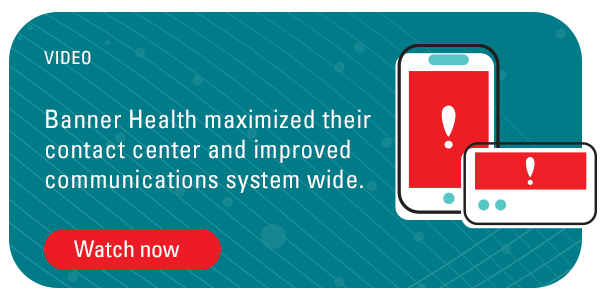Hospital contact centers: the essential guide

The growing role of hospital call centers
Over the years, hospital contact centers have greatly expanded the responsibilities of their traditional agents. Once charged solely with fielding calls and directing phone inquiries, today’s contact center staff serve as a multi-functioning communication hub that is mission critical for the operation of a hospital or healthcare facility. In fact, contact centers contribute to the patient experience.
Successful healthcare call centers play a vital role in helping busy clinicians provide well-coordinated care. Medical call center staff are often expected to develop advanced skills in customer service, emergency dispatch, and messaging to support a multitude of organizational functions. They must be nimble enough to field, manage, and route a wide array of incoming calls, and also perform many diverse tasks.
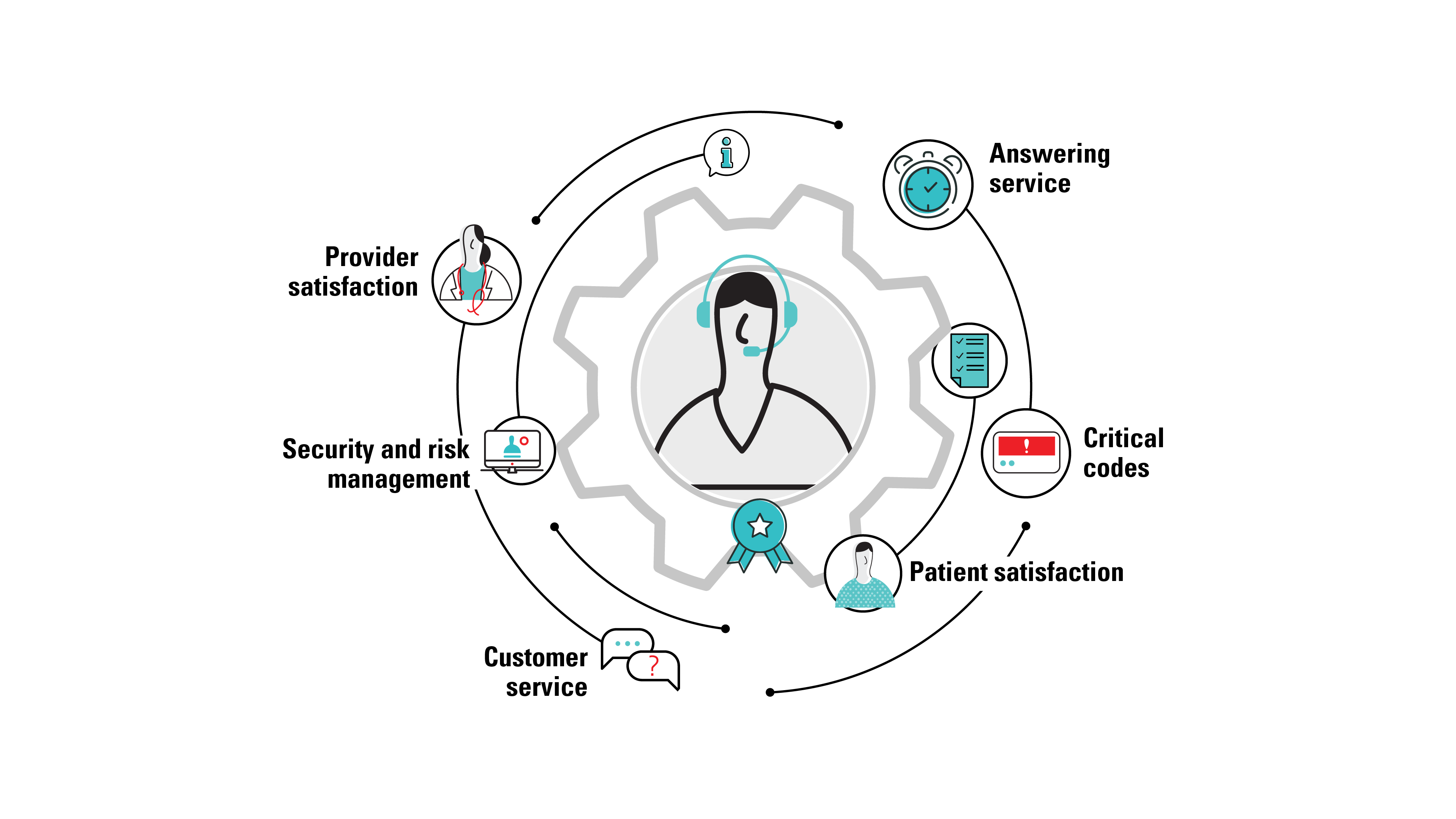
Common contact center agent tasks include:
- Providing top-notch service to all callers
- Keeping online directories updated
- Maintaining on-call physician/provider calendars
- Helping care teams connect
- Providing answering services
- Coordinating emergency code responses
- Scheduling appointments and making reminder calls
- Providing bed assignments/tracking assistance
- Taking patient room service requests
- Cross-referencing callers to additional programs and services
- Coordinating patient transfers to and from other facilities
The following four tips will give insight into how you can support the ever-expanding role of your medical call center within your organization.
1. Increase communication efficiency
With all the responsibilities on an agent’s plate, healthcare call center software that can help them be more efficient is a must. One of the biggest time-saving opportunities for many hospitals is to provide the contact center with an integrated, intuitive communication hub. Beyond a console to help answer calls, a truly unified solution brings together all the information and applications on one screen that an on-site or remote agent needs to access. In addition, tools such as interactive speech and online directories can help reduce caller traffic to the contact center, giving your staff more time for other duties.
Consoles
When first introduced, the ability to process phone calls through computer systems revolutionized contact centers. Since then, contact center technology has allowed call centers to become so much more than just call-answering software. A comprehensive console solution is one that integrates with all the resources agents need to access for their duties, from staff directories and paging systems, to bed tracking and room service, all with the goal of improving clinical communication and patient safety.
With everything available at their fingertips, including detail down to the type of mobile device on which each provider prefers to be contacted, agents can use a few clicks to save a significant amount of time that was previously spent referring to rotary card files, paper binders, white boards, and sticky notes.
Interactive speech software—also called interactive voice response (IVR) technology—can be used to cut costs, improve customer satisfaction, and increase productivity in the contact center. Waiting in a queue to connect with an agent or, worse still, finally being put through to the wrong person, can be very frustrating to your callers. With interactive speech there is no waiting. Callers speak their request, and the system can direct most calls without involving an agent. Healthcare systems are using this technology to make contact centers more efficient, giving agents the ability to manage rising call volumes easily and professionally with more time to devote to handling special requests and other key duties.
Online directories
Online directories are a valuable tool for hospitals because they increase staff productivity while improving contact center efficiency, employee satisfaction, and cost savings. Providing staff with access to a reliable, up-to-date source for contact information and on-call schedules eliminates the need for contact center agents to be in the middle and transfer calls between employees.
The reduction in internal call traffic gives agents more time to devote to other activities. Online access also means staff members have the freedom to log on anywhere, anytime to search the directory, verify that their own information is correct, update on-call schedules, and send important messages.
Online on-call schedules
The benefits of online contact information extend beyond just reducing caller traffic. Web availability eliminates the need for costly (and quickly outdated) printed directories. With on-call scheduling software, updates are immediately available, helping make sure the right people are being contacted around the clock. Accessing information is faster than flipping through paper binders.
Web-based information also enables individual departments to take ownership of entering schedule information, removing this time-consuming task from the contact center’s growing list of responsibilities. Eliminating the need for printed materials saves money and can significantly reduce the amount of time spent on administrative tasks, giving your staff more time to focus on what they do best: coordinating communications and delivering excellent customer service.
2. Improve incident management
There are many situations when you urgently need to alert a specific group of people. Contact centers initiate code calls for everything from patient resuscitation and fires to infant abductions, dangerous weather, and local disasters that result in an unexpected influx of patients. Coordinating emergency response and alerting staff to time-sensitive situations requires fast, accurate announcements and are crucial to patient and facility safety.
Code calls
 Initiating code calls involves much more than a hastily issued overhead announcement. Responses must be tracked and escalated, if necessary, to ensure enough people answer the call for help. Mobile devices (smartphones, Wi-Fi phones, pagers, etc.) offer opportunities beyond overhead pages to notify responders, but they can also make
Initiating code calls involves much more than a hastily issued overhead announcement. Responses must be tracked and escalated, if necessary, to ensure enough people answer the call for help. Mobile devices (smartphones, Wi-Fi phones, pagers, etc.) offer opportunities beyond overhead pages to notify responders, but they can also make
reaching the right people more complicated. Mobilizing your staff depends on fast,
accurate dissemination of critical information to the right devices. Today’s technology solves
both these challenges—reaching the right people quickly and tracking their availability.
A good emergency notification and incident management system provides instant messaging options, including pre-programmed templates to notify specific groups of employees, such as rapid response teams, on their mobile devices. These pre-written, automated messages save critical time in emergencies—when every second counts—by eliminating the need for calling trees.
Innovative technology can help improve communication effectiveness by automatically delivering messages, tracking responses, and escalating to additional staff, if necessary. Agents oversee the process and can intervene if necessary. However, having technology with pre-configured templates and information about the correct escalation path based on a provider’s availability and preferred device removes time-consuming tasks. This bypasses the need to type pages, manually track responses, and locate additional providers when primary contacts fail to respond on time.
Assure superior call quality
Call recording technology is another valuable feature in the changing landscape of hospital contact centers. Recording phone calls and concurrent screen activities helps identify opportunities for improving protocols to enhance call quality and professionalism. Particularly in complex areas such as emergency coordination, hospital call recording also enables centers to document the handling of code calls and other time-sensitive situations.
Ensuring the information is readily available for auditing purposes allows hospitals to retrace an event in case there are disputes about the response. The appropriate technology for recording and evaluating how all calls are handled gives contact center management and agents the tools and training they need to continually deliver top-notch customer service for every call.
3. Provide cost savings
Hospitals and healthcare systems continually strive to reduce costs while maximizing patient care. Contact center consolidation is a major trend in modern communications, with one location handling the call answering for multiple regional facilities. Today’s economic climate points strongly toward centralized telephone answering for contact centers in general. Operators working in larger groups do so far more efficiently than multiple small groups of agents.
Learn about six advantages of a consolidated contact center >>
Contact centers are generally viewed as a necessary expense for running a facility. However, contact center communication technology is evolving to support greater efficiencies and expanded capabilities. This is important in an increasingly competitive landscape as the healthcare industry looks for innovative ways to engage with existing and potential customers.
For example, appointment reminder calls can reduce lost revenue from missed appointments. In addition, providing after-hours answering services for affiliated physician practices can generate revenue and increase control over the full customer service experience.
Supporting on-site and remote agents
Many contact centers successfully operated with remote agents during the pandemic. Fully remote and hybrid working arrangements are now much more common, and remote contact center solutions are able to support these flexible approaches while keeping all team members connected and reducing costs.
4. Build patient loyalty
The contact center is often the first point of contact for healthcare consumers. Improving the patient experience is essential and a good first impression can influence a caller’s decision to become your patient. So it’s important to position your agents as ambassadors of your hospital’s brand. Successful organizations recognize that efficient and courteous service is a highly valued asset, and they support contact centers with the right tools to reduce call abandonment and assure professional, individualized caller experiences.
Up-to-date, online directory information and on-call schedules available right from the console can significantly reduce the amount of time agents spend searching for contact information, helping to reduce staff burnout. and interactive speech can provide fast transfers for routine calls. Excellent service makes the contact center a cost-effective way to increase customer loyalty and boost patient revenue through referrals and increased participation in hospital programs. Likewise, a well-run contact center supports improved patient care by helping to coordinate clinical communications. This can ultimately help boost patient satisfaction scores.
Get started
In a continually evolving environment, how do you assess whether your contact center is using best practices and the right technology to maximize its potential? Before you start evaluating your existing software or new platforms, the first step is to make a list of what functions your contact center currently performs, the internal systems that interface with the contact center, and what functions you would like to offer in the future.
Remember to consider your organization’s vision and mission and seek input from staff members at every level of the hospital. You may gain valuable insight about your strengths, weaknesses, and the direction to move forward. The benefits of incorporating or upgrading new technology into your existing contact center will enable you to improve efficiencies and trim costs.
The bottom line
Healthcare organizations rely on contact centers to deliver exceptional customer service while supporting exemplary patient care. Technology helps contact centers streamline their operational efficiencies, enhance the patient experience, and reinforce a positive brand image.
Looking for more?
Explore our curated selection of resources designed to enhance your understanding and application of high-performing web strategies. Dive into expert insights, case studies, and actionable guides that align with your goals.
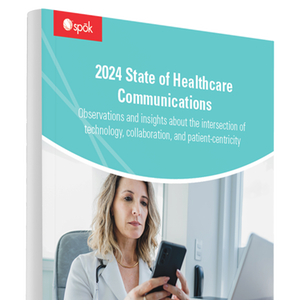
eBook: State of Healthcare
A description of the resource being shared. Just a couple of sentences should be just right.
Download >>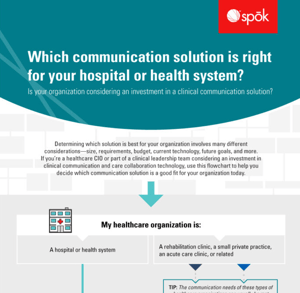
Infographic: Which solution is right for you?
A description of the resource being shared. Just a couple of sentences should be just right.
Download >>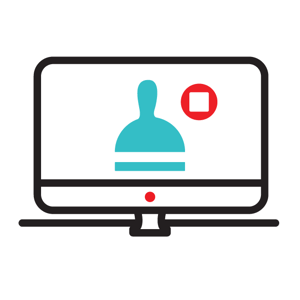
Webinar: The ongoing power of paging
A description of the resource being shared. Just a couple of sentences should be just right.
Watch now >>
eBook: 3 ways to maximize your contact center
Learn three tips to help maximize your contact center in your healthcare organization
Get my free copy >>
Case Study: Orlando Health
Tired of fragmented systems and long training times? Read how Orlando Health improved its agent experience by consolidating everything into a single application, allowing them to provide faster, more consistent service.
Read how they did it >>
Webinar: Creating a unified communication platform
Fragmented systems hinder healthcare. Join Spok to see how a unified platform integrates enterprise data and enhances clinical communication for seamless workflows and better patient outcomes.
Watch the free recording >>

